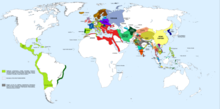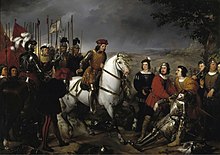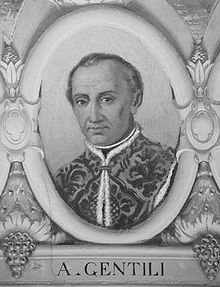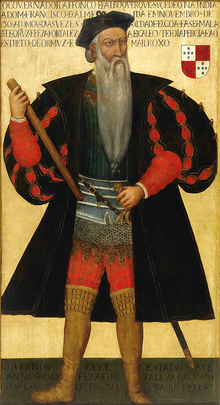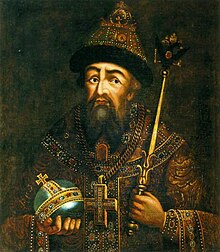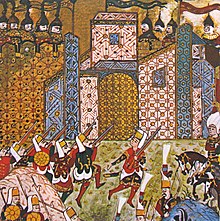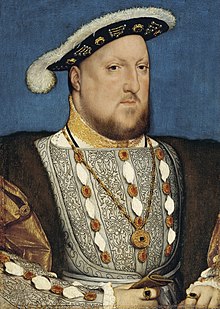Century XVI

The 16th century d. C. (sixteenth century AD) or XVI century and. c. (sixteenth century of the Common Era) began on January 1, 1501 and ended on December 31, 1600. It is called the «Century of Discoveries». After the arrival in America of Christopher Columbus and whose expedition was paid for by Spain. It began in the Julian year 1501 and ended, in both the Julian and Gregorian calendars, in the year 1600 (depending on the computation used; the Gregorian calendar introduced a 10-day span in October 1582).
He saw Spain and Portugal explore the so-called New World. With the conquest and subjugation of the Aztec, Muisca, Mayan, and Inca empires, the Spanish Empire extended its domain from present-day California to the Biobío River in Chile, making it the largest global empire for 300 years. In general, the 16th century was a period of economic boom for Europe.
Spain emerged as the superpower of this century and assembled a gigantic empire, with possessions all over the world. It reached its apogee by incorporating the Portuguese Empire. It dominated vast American territories, from the current United States to the area of Chile and Argentina, possessions around Africa, numerous colonies in Asia as a result of the conquest of Portugal. In addition to half Italy, the Netherlands, Burgundy, etc.
Following the discovery of America at the end of the 15th century, the XVI continued with the great explorations, mainly Spanish and Portuguese, through the New World, the Pacific, Asia, etc. Spain completed the first circumnavigation of the world in history. The economy was globalized, creating a primitive capitalism.
In Europe, the Protestant Reformations challenged the authority of the papacy and the Catholic Church. In England, the authoritarian Henry VIII separated the papal authority of the kingdom from him, and he established himself as head of the Anglican Church so that he could divorce. These religious wars sparked later, in the 17th century, the Thirty Years' War, which ended the supremacy of the House of Habsburg in Europe. Meanwhile, in the Middle East, the Ottoman Empire under Suleiman the Magnificent continued to push into the heart of Europe after its conquest by the Byzantine Empire.
1500
- The Stories from Polibio translated to Italian, English, German and French.
- Myssipian culture disappears.
- Alfombra medallon, variant Ushak star style, Anatolia (modern Turkey), is made. It is now stored at the Saint Louis Art Museum.
Relevant events
Wars and conquests
- 1501-1504: the Naples War breaks out between Spain and France for the control of the Kingdom of Naples.
- 1503: The Spanish Empire defeats France in the battle of Ceriñola, considered the first battle where firearms were used.
- 1506: Poland is invaded by the Crimean Tatars.
- 1509: Portugal overcomes in the battle of Diu a fleet of Ottomans, Venetians and Mamluks.
- 1512: The kingdom of Navarre is occupied by the kingdoms of Castile and Aragon.
- 1513: Vasco Núñez de Balboa discovers the Pacific Ocean and baptizes it with the name "South Sea".
- 1516: Juan Díaz de Solís discovers the current Uruguay and the Rio de la Plata which cost him his life.
- 1516-1517: the Ottomans defeat the Mamluks and are done with the control of Egypt and Arabia.
- 1519: Ottoman pirates under the command of Admiral Barbarossa are rooted in southern France.
- 1519-1521: Hernan Cortes conquers the Aztec Empire.
- 1520-1566: the Ottoman Empire arrives at its cénit.
- 1521: Belgrade is captured by the Ottomans.
- 1522: Rhodes is captured by the Ottomans.
- 1523: Sweden is established as an independent kingdom after the Kalmar Union.
- 1525: The Spanish Empire and the Holy Roman-German Empire defeat France in the battle of Pavia where King Francis I himself falls prisoner by Antonio de Leyva.
- 1526: The Ottoman Empire beats Hungary in the battle of Mohács where King Louis II of Hungary died.
- 1527: the Sake of Rome is produced by the troops of Emperor Charles V.
- 1529: Austrian troops defeat the Ottomans at the decisive site of Vienna.
- 1529: Through the Zaragoza Treaty, the Philippines is under the control of the Spanish Empire and the Moluccas, under the control of Portugal.
- Dr Alberico Gentili, the father of international law.
- Battle of Ceriñola
- The Great Captain finds the body of Louis d'Armagnac, Duke of Nemours.
- Albuquerque Afonso
- Vasili III, by André Thévet.
- 1529-1532: Civil war in the Inca Empire between Huáscar and his half brother Atahualpa.
- 1532-1533: Francisco Pizarro begins the conquest of the Inca Empire.
- 1534: Ottomans capture Baghdad.
- 1535: the armies of Emperor Charles V conquer Tunisia.
- 1536: the War of Arauco begins.
- 1537-1539: Gonzalo Jiménez de Quesada begins the conquest of the Musca Confederation.
- 1538: an Ottoman fleet defeats a Hispanic-Venezuelan fleet in the battle of Preveza.
- 1540-1551: the indigenous rebellion known as the War of the Mixed in the Territory of New Spain is developed.
- 1541: In Algeria, a military invasion of the Spanish king Carlos V failed.
- 1544: France defeats a German-Spanish army in the battle of Cerisoles.
- 1547-1600: the Chichimeca War is developed as a product of the expansion of New Spain to the north to be made with the mining resources of the region.
- 1547: Emperor Charles V beats the Enamel League in the battle of Mühlberg.
- 1547: It is crowned Ivan IV of Russia, being the first zar of the history of Russia.
- Portrait of Iván el Terrible.
- 1550: Mongols invade China and sitian Beijing.
- 1552: Russia conquers Kazan kanato.
- 1553: Mary I of England becomes the queen of England, happening to her father, Henry VIII.
- 1556: Russia conquers the kanato of Astracán.
- 1556: Akbar the Great defeat to Bengal Sultan in the Second Battle of Panipat
- 1556 - 1605: During his reign, Akbar expands the Mogol Empire in a series of conquests (in the Indian subcontinent).
- 1556: Mir Chakar Khan Rind captured Delhi with Emperor Humayun.
- 1558: The kingdom of England loses the city of Calais at the hands of France, which had been under control for 200 years.
- 1558: France recovers the city of Calais, which had been under the control of England for 200 years.
- 1560: In the battle of Los Gelves, an Ottoman fleet beats a Hispanic-Venetian fleet.
- 1560: In Japan, Oda Nobunaga is controlled by the whole country.
- 1565: Hospitaller Knights, supported by the Spanish Empire, beat the Ottomans on the site of Malta
- 1568-1648: The War of the Eighty Years occurs in the Netherlands, where the United Provinces will become independent of the Spanish domain.
- 1569: the Republic of the Two Nations is created with the Union of Lublin.
- 1571: the fleet of the “Santa” League defeats the Ottoman fleet in the battle of Lepanto.
- 1571: Crimean Tatars take and plunder Moscow, burning everything except the Kremlin.
- 1572: Francis of Toledo ends the conquest of the Inca Empire with the murder of Tupac Amaru ID
- Fernando Alvarez de Toledo.
- 1573: the siege of Haarlem ends with Spanish victory.
- 1574: The Dutch rebels resist in the siege of Leiden.
- 1576: The Spanish Tercios are mutiny in Aalst, they go to Antwerp and plunder it, for lack of payments.
- 1578: the king of Portugal, Sebastian I of Portugal, dies in the battle of Alcazarquivir.
- 1579: the Utrecht Union formalizes the United Provinces of the Netherlands.
- 1580: the Spanish and Portuguese crown is unified in Philip II.
- 1584-1585: the Spanish Tertia asedian Antwerp, and ends with a great victory for Spanish weapons.
- 1585-1604: the Anglo-Spanish War will end with the London Treaty.
- 1588: the disaster of the Invincible Navy occurs, thus failing the Spanish plan for which the thirds were intended to invade England and destroy Isabel I.
- 1592-1598: Korea rejects two Japanese invasions with the help of China.
- 1600: The Battle of Sekigahara is produced, which begins the Edo Period in Japan with the Tokugawa domain.
Science and technology
- 1543: Nicolás Copernico publica From revolutionibusin which he proposes heliocentric theory.
- 1553: Miguel Servet publishes The Restitution of Christianity book that would lead him to die in the bonfire.
- 1600: Execution of Giordano Bruno for heresy in Rome.
Religion
- 1506: Christianity becomes the official religion of the Kingdom of the Congo.
- 1517: beginning of the Protestant reform by Martin Luther (95 thesis).
- 1527: Protestant Reform begins in Sweden.
- 1531: In the hill of Tepeyac, Mexico appears Our Lady of Guadalupe to San Juan Diego, thus beginning the evangelization of New Spain.
- 1531-32: the church of England breaks with the Roman papacy and proclaims King Henry VIII head of the Anglican Church
- 1543: beginning of the Counter-Reform: "Concilio de Trento"
- 1562-1598: France's wars of religion occur between Catholics and Protestants, known as Hugonotes.
- 1571: Pope Pius V creates the Holy League headed by Spain and formed by Venice, Malta and the Pontifical States
- 1589: in Quito, Ecuador, appears for the first time Our Lady of the Good Success to Mother Mariana of Jesus Torres and Berriochoa, religious conceptionist and one of the founders of the Royal Monastery of the Clean Conception of Quito.
- 1598: The Edict of Nantes puts an end to the wars of religion of France.
Disasters
- 1507: A smallpox epidemic causes havoc on the island of La Española.
- 1556: the Shaanxi earthquake, the most deadly in recent history, is taking place, killing 8300,000 people.
- 1563: A plague rooted in England, 80,000 people die.
- 1570: Ivan the Terrible orders the massacre of the inhabitants of Novgorod.
Culture
- 1502: The first presences of African slaves in America are found.
- 1503: Leonardo da Vinci begins to work in his famous painting The Mona LisaIt'll end three years later.
- 1506: Christopher Columbus dies in Valladolid.
- 1508-1512: Michelangelo paints the Sistine Chapel
- 1513: Machiavelli writes his novel The Prince dedicated to César Borgia.
- 1513: The Portuguese arrive in Honduras.
- 1519: the Magellan-Elcano Expedition of Sanlúcar de Barrameda.
- 1521: Fernando de Magallanes arrives in the Philippines and dies that same year.
- 1522: Juan Sebastián Elcano ends the first successful circumnavigation of the planet.
- 1533: Pedro de Heredia founded the city of Cartagena de Indias.
- 1535: Francisco Pizarro founded the city of Lima.
- 1538: Gonzalo Jiménez de Quesada founded the city of Bogotá.
- 1541: The Amazon River is discovered by Francisco de Orellana.
- 1541: Pedro de Valdivia founded the city of Santiago de Chile.
- 1550-1556: Giovanni Battista Ramusio's travel book is published in Venice.
- 1554: published Lazarillo de Tormes.
- 1554: Portuguese missionaries founded the city of São Paulo in Brazil.
- 1556: the Spanish conquerors begin the Santa Week processions in Popayán.
- 1563-1584: beginning and completion of the work of the Monastery of El Escorial.
- 1577-1580: Francis Drake turns the world around.
- 1582: Pope Gregory XIII set up the Gregorian calendar (created by the mathematicians of his court) to replace the Julian calendar that Julius Caesar created.
- 1597: the first Opera in Florence by Jacopo Peri
- 1597: published Romeo and Juliet by William Shakespeare
This period is called the century of geniuses, for the appearance of the three great artists: Leonardo da Vinci, Raphael and Michelangelo.
Relevant people
- Alberto Durero (1471-1528): German painter and writer of the Renaissance.
- Alexander Farnesio (1545-1592): Duke of Parma, great military, diplomatic and governor of the Netherlands.
- Alexander VI (1431-1503): Pope No. 214 of the Catholic Church.
- Ana Bolena (1501-1536): Queen consort of England, wife of Henry VIII, first queen to be executed.
- Andrés Vesalio (1514-1564): anatomist flamenco.
- Caravaggio (1571-1610): Italian painter, maximum exponent of baroque painting.
- Charles I of Spain and V of the Holy Roman German Empire (1500-1558): emperor of the Holy Roman German Empire and king of Spain.
- Catherine de Médici (1519-1589): queen consort of France for her marriage to Henry II of France and later regent of France.
- César Borgia (1475-1507): General captain of the papal army.
- Christopher Marlowe (1564-1593): poet, playwright and English translator.
- Malinalli (1501-1551): interpreter, strategist and couple of Hernan Cortés conqueror of the Aztec Empire.
- Cuauhtémoc (1502-1523): last tlatoani (sovereign) of the Aztec Empire.
- Cosiiopii II (1502-1563): Last Cove (Sovereign) of the Kingdom of Zaachila.
- Edward VI of England (1537-1553): King of England and Ireland, followed with the reforms of the Anglican Church.
- El Greco (1541-1614): Spanish painter of the Renaissance of Greek origin.
- Henry IV of France (1553-1610): King of France and Navarre.
- Henry VIII of England (1491-1547): King of England and Ireland, was established as head of the Anglican Church.
- Erasmus of Rotterdam (1466-1536): theologian, philosopher and Dutch humanist.
- Philip II of Spain (1527-1598): King of the Spanish Empire and King of England.
- Fernando de Magallanes (1480-1521): Portuguese navigator and explorer.
- Francis Bacon (1561-1626): English writer, philosopher and politician.
- Francis I of France (1494-1547): King of France.
- Francis Drake (1540-1596): English explorer and courtier.
- Francisco de Orellana (1511-1546): Spanish explorer, discoverer of the Amazon River.
- René Descartes (1596-1650): rationalist philosopher.
- Francisco Pizarro (1475-1541): Spanish explorer, conqueror of the Inca Empire.
- Francisco Vázquez de Coronado (1510-1554): Spanish explorer, famous for seeking El Dorado.
- Galileo Galilei (1564-1642): astronomer, philosopher, mathematician and Italian physicist.
- Gerardo Mercator (1512-1594): Flemish cartographer.
- Giordano Bruno (1548-1600): philosopher, astronomer and Italian writer, accused of heresy by the Catholic Church.
- Giovanni da Verrazzano (1485-1528): Navigator and Florentine explorer.
- Giovanni Battista Ramusio (1485-1557): Venetian geographer and writer.
- Hans Holbein the Young (1497-1543): German painter, portrait master.
- Hernán Cortés (1485-1547): Spanish military and explorer, conqueror of the Aztec Empire.
- Ignatius of Loyola (1491-1556): Spanish religious and theologian, founder of the Society of Jesus.
- Elizabeth I of England (1533-1603): Queen of England, her reign was called the island Age.
- Ismail I (1487-1524): Sah of Iran.
- Ivan IV of Russia (1530-1584): Russian tsar, known with the nickname «Iván el Terrible».
- Jacques Cartier (1491-1557): French navigator and explorer, discoverer of Canada.
- John Knox (1514-1572): priest, leader of the Protestant Reform in Scotland and founder of presbytery.
- Johannes Kepler (1571-1630): astronomer, German scientist and mathematician.
- Juan Calvino (1509-1564): French theologian, founder of Calvinism.
- Juan Ponce de León (1460-1521): Spanish military and explorer, Florida discoverer.
- Juan Sebastián Elcano (1476-1526): Spanish navigator, first man to turn around the world.
- Lautaro (1534-1557) Mapuche military chief.
- Lope de Vega (1562-1635): Spanish poet and playwright.
- Luis de Camões (1524-1580): Portuguese writer and poet.
- Manuel I of Portugal (1469-1521): Portuguese king.
- Mary I of Scotland (1542-1587): queen of Scotland, queen consort of France, known as Mary Queen of Scotland decapitated by Elizabeth I of England.
- Mary I of England (1516-1558): English queen, and consort queen of Spain.
- Martin Luther (1483-1546): religious reformist of German origin.
- Michel de Montaigne (1533-1592): French writer, philosopher, humanist and politician.
- Michelangelo (1475-1564): Renaissance Italian painter, architect and sculptor.
- Miguel de Cervantes (1547-1616): military, writer and Spanish poet.
- Miguel el Valiente (1558-1601): Prince of Valaquia, Transylvania and Moldova.
- Musashi Miyamoto (1584?-1645): one of the most famous warriors of feudal Japan.
- Nicolas Copernicus (1473-1543): Polish astronomer.
- Nicolas Machiavelli (1469-1521): Italian writer, philosopher and diplomat.
- Nostradamus (1503-1566): doctor and astrologer, author of prophecies.
- Oda Nobunaga (1534-1582): daimyō of the Sengoku period in Japan.
- Pieter Brueghel el Viejo (1525-1569): a painter from the Duke of Brabante.
- Pius V (1504-1572): Italian pope and saint.
- Rafael (1483-1520): Italian painter and architect.
- Solián the Magnificent (1494-1566): sultan of the Ottoman Empire, during his government the empire reached its peak.
- Suatmarama (XV-XVI century), Indian religious writer.
- Tintoretto (1518-1594): Venetian painter.
- Titian (1477-1576): Italian painter of the Renaissance.
- Thomas Hobbes (1588-1679): philosopher and theorist of political absolutism.
- Thomas Moro (1478-1535): English writer, theologian and politician.
- Toyotomi Hideyoshi (1537-1598): Japan's daimyō during the Sengoku period.
- Vasco Núñez de Balboa (1475-1519): Spanish military and explorer.
- William Shakespeare (1564-1616): English writer and poet.
Contenido relacionado
Paleontology
New Testament
History of Spain
